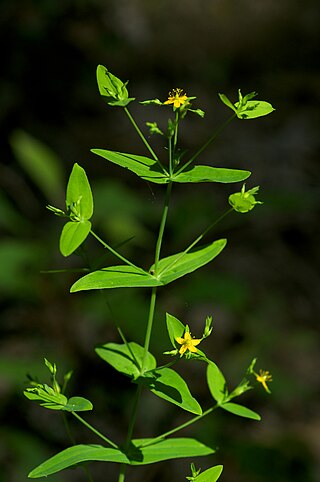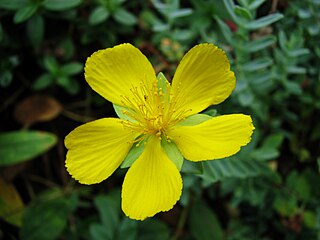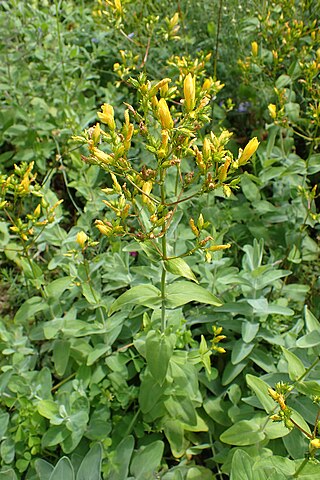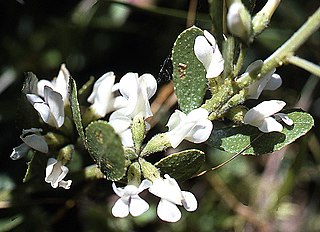
Hypericum perforatum, commonly known as St John's wort, is a flowering plant in the family Hypericaceae. It is a perennial plant that grows up to one meter tall, with many yellow flowers that have clearly visible black glands around their edges, long stamens, and three pistils. Probably a hybrid between the closely related H. attenuatum and H. maculatum that originated in Siberia, the species is now found worldwide. It is native to temperate regions across Eurasia and North Africa, and has been introduced to East Asia, Australia, New Zealand, and parts of North and South America. In many areas where it is not native, H. perforatum is considered a noxious weed. It densely covers open areas to the exclusion of native plants, and is poor grazing material. As such, methods for biocontrol have been introduced in an attempt to slow or reverse the spread of the species.

Hypericum is a genus of flowering plants in the family Hypericaceae. The genus has a nearly worldwide distribution, missing only from tropical lowlands, deserts and polar regions. Many Hypericum species are regarded as invasive species and noxious weeds. All members of the genus may be referred to as St. John's wort, and some are known as goatweed. The white or pink flowered marsh St. John's worts of North America and eastern Asia are generally accepted as belonging to the separate genus TriadenumRaf.

Asplenium rhizophyllum, the (American) walking fern, is a frequently-occurring fern native to North America. It is a close relative of Asplenium ruprechtii which is found in East Asia and also goes by the common name of "walking fern".

Hypericum mutilum is a species of St. John's wort known by the common name dwarf St. John's wort. It is native to parts of North America and is present in other parts as an introduced species. It is an annual or perennial herb taking a multibranched erect form up to about 60 centimeters tall. The oval green leaves are one or two centimeters long and are covered in tiny glands. The inflorescence is a compound cyme of tiny flowers. H. mutilum subsp. mutilum and subsp. boreale have a diploid number of 16, and H. mutilum subsp. boreale can have a diploid number of 18.

Hypericum olympicum, commonly known as the Mount Olympus St. John's wort, is a species of flowering plant in the family Hypericaceae found in the Balkans and Turkey and introduced to western Europe. It has been widely cultivated for centuries because of its large, showy flowers, which are far larger than those of most other species in Hypericum.

Hypericum aegypticum is a species of flowering plant of the St. John's wort family (Hypericaceae) which is native to the Eastern Mediterranean. It was described by Carl Linnaeus in the second volume of his Species Plantarum in 1753, who named it after Egypt despite it not being distributed there. The plant is commonly known as shrubby St. John's wort or Egyptian St. John's wort in English. Like other members of section Adenotrias, it is found among limestone rocks in coastal areas. While it has been evaluated as threatened on the island of Malta, the species has no legal protections.

Hypericum annulatum is a species of flowering plant in the family Hypericaceae. It is a perennial herb of varying heights which grows upright, with more than a hundred flowers of a golden yellow color. First described in 1827, the species has a wide distribution from Eastern Europe to East Africa, and its appearance can vary greatly based on its geographic location. It has been used in Bulgarian folk medicine, and has more recently been investigated for its effectiveness in slowing the growth of or killing certain types of human cancer.
Hypericum collinum is a flowering plant in the family Hypericaceae which is found in Mexico.

Hypericum undulatum, the wavy St Johns Wort, is a herbaceous perennial flowering plant native to western Europe and northern Africa. The specific name undulatum is Latin, meaning "wavy" or "undulated", referring, just as the common name, to the wavy leaf margins of the herb. The plant has a diploid number of 16 or 32.

Hypericum oblongifolium, known as Pendant St. John's wort, is a species of flowering plant in Hypericumsect. Ascyreia.

Hypericum sechmenii, or Seçmen's St John's wort, is a rare species of flowering plant of the St John's wort family (Hypericaceae) that is found only in the Eskişehir Province of central Turkey. Its appearance and characteristics were first described in 2009 by Turkish botanists Atila Ocak and Onur Koyuncu, who named the species in honor of Özcan Seçmen, a fellow botanist. After this description, the species was incorporated into the organization of the genus Hypericum by Norman Robson, who placed H. sechmenii into section Adenosepalum. It is a perennial herb which grows in clusters of stems 3–6 centimetres (cm) tall and blooms in June and July. The stems of the plant are smooth and lack hairs, while the leaves are leathery and do not have leafstalks. Its flowers are arranged in clusters that form a flat-topped shape known as a corymb, and each flower possesses five bright yellow petals. There are several species that are similar in appearance to H. sechmenii, with only minor physical differences that set them apart. The most closely related of these are Hypericum huber-morathii, H. minutum, and H. thymopsis.

Hypericum przewalskii, commonly called Przewalski's St. John's wort, is a flowering plant in Hypericumsect. Roscyna that is native to China.

Hypericum aucheri, also known as Koramanotu in Turkish, is a herbaceous perennial flowering plant in the St. John's wort family Hypericaceae.

Hypericum coris, the heath-leaved St. John's wort, also called yellow coris, is a species of flowering plant in the family Hypericaceae, and is the type species of sect. Coridium. It is a low shrub, and it is found in Switzerland and northwestern Italy. The species has been a popular garden plant since the 18th century, valued for its long flowering period and for how well it adapts to cultivation.

Hypericum heterophyllum is a flowering plant in the Hypericaceae family and is the only species in Hypericum sect. Heterophylla.
Otholobium dreweae is an upright shrublet assigned to the Pea family of about 15 cm (5.9 in) high, that appears after the vegetation burned down from the underground rootstock and forms mat-like clumps of hardly branching, leafy stems. The stems are set with stiff, entire, alternate leaves with a single leaflet and heads consisting of 12-18 initially dark pink, later white, pea-like flowers with a white nectar guide on a peduncle as long as the leaves at the end of the stem. This species is an endemic of the Kleinrivier Mountains in the Western Cape province of South Africa. It mostly flowers in November.

Otholobium lucens is a shrub of up to 60 cm (24 in) high that is assigned to the pea family. It has alternately set clover-like leaves crowding on the new growth, while older parts have lost their leaves. The white, pea-like flowers occur with 3 or 6 together in the leaf axils. This rare species is an endemic of the Swartberg mountains in the Western Cape province of South Africa. It flowers between July and February.

Hypericum orientale, the Ptarmic-leafed St. John's wort or Eastern St. John's wort, is a flowering plant in the family Hypericaceae. It is distributed across northern Turkey, Georgia, the Caucasus, and Dagestan. The species can be found on stony sloped amidst volcanic rocks in the mountains and in light woodlands at elevations of up to 2,300 m (7,500 ft). It flowers from May to June and July to August. The plant has small, bright yellow flowers and grows across the ground in a creeping pattern. It prefers full sun and is ideal for rock gardens, and is hardy down to -30°F.
Hypericum hirtellum is a species of flowering plant in the family Hypericaceae. It is native to Iran and Iraq and is found on chalky, sandy soil at elevations of 300–2,000 meters.















